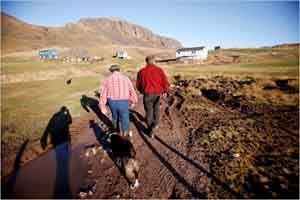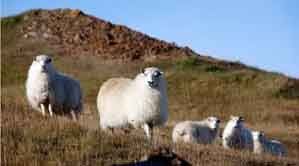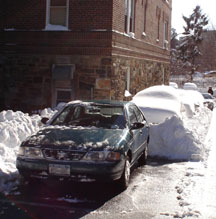Greenland Thaws is a series of 13 photos by John McConnico on the NYT website, that will give you pause. I photoshopped a few of them, including captions:

Greenlandic farmers are experimenting with vegetables that have never been grown commercially in the country. Kenneth Hoeg, the region’s chief agriculture adviser, says he does not see why southern Greenland cannot eventually be full of vegetable farms and viable forests.

Ewes are having fatter lambs, and more of them every season. The growing season, such as it is, now lasts roughly from mid-May through mid-September, about three weeks longer than a decade ago.

People come from all over to gape at the plants, like these decorative cabbage, growing at [agricultural research station] Upernaviarsuk.

A Greenlandic supermarket is stocking locally grown cauliflower, broccoli and cabbage this year for the first time.
Back in the early 1960s, when global warming was only a theory, scientists predicted that the effects would be most dramatic in the polar regions. This is borne out by the dramatic lengthening of the growing season in Greenland, versus lower latitudes.
This posting is kind of a Rorshach test. Those from a limited perspective may see this single data point as evidence of human ingenuity and adaptability in the face of change, a triumph of free market economics, and conclude that global warming is not as serious as some make it to be. Those from a larger, planetary perspective, will likely be alarmed, for they understand that the earth’s climate is a large and complex system, with many feedback loops and interdependencies, and that a change at one point can trigger dramatic, and less benign changes elsewhere. The world’s leading scientists have articulated many of them.
I’m not a climate scientist, but I am a student of chaos mathematics and physics. I wish I could tell you where I first heard this, but a useful analogy is to envision the earth’s climate as a beach ball at rest between a particular set of sand dunes. It has mostly been in this stable state – resting between a particular set of dunes – since the last ice age. A few breezes may have rocked the ball from time to time, creating mini ice ages for example, but the earth’s atmospheric and oceanic currents have remained in the same configuration since the end of the last ice age.
Global warming represents a large enough energy input that could cause this ball to move, potentially kicking it into the air, where it would ultimately come down and find a new equilibrium, a new resting spot, possibly between a new set of sand dunes. As the beach ball moves to a new resting point, the ocean and atmospheric currents are reconfigured, dramatically altering worldwide weather and habitat.
The ice ages, and the intervening, opposite periods of relative warmth – are similar reconfigurations from the past, times when the beach ball was kicked into a new region on the beach. Transition periods – when the climate is seeking a new equilibrium – when the old pattern is dissolving and the new has yet to emerge – analgous to times when the beach ball is in motion – is the disaster scenario that disrupts everything, not just the lives of farmers in Greenland.
No one knows whether the climate has reached this particular tipping point – whether the ball is airborn and seeking a new equilibrium, invoking this disaster scenario – but it’s significant that the system has feedback loops, amplifying the inputs which push it toward this point of no return.
Al Gore is more optimistic than I, regarding our ability to deal with global warming. It would be one thing if we had a functioning, forward thinking government that could lead the world’s richest, most able nation – as well as the rest of the planet – into something approaching ecotopia, but we’re presently cursed with the most backward, unconscious leaders this country has ever seen, and lots of inertia and brokenness after they leave. This doesn’t even consider Lord Cheney’s demonic lust for a massively bigger conflagration in the Middle East by attacking Iran.
Despite the Democrats’ likely sweep in 2008, and despite the relative sanity of the leading Democratic candidates, my fear about 2008 is that it may be too little, too late – all the moreso if a triangulator like Hillary wins. I hope I’m wrong. I’d be more optimistic if the leading candidates were serious about getting out of Iraq, which is a proxy for admitting and coming to terms with America’s oil addiction, a root cause of global warming. I’d be even more optimistic if the leading candidates were serious about atoning for our country’s shameful acts overseas – necessary to move past war, and to get to cooperation, and to begin to make real progress on living in harmony on the earth. It can be done, if we want it. If the leaders are unwilling, we individual citizens will have to find ways to do this from the grass roots.
If we don’t change course in time, I foresee a period of resource wars – Iraq is the opening battle – which will ultimately be trumphed by the accelerating effects of climate change. It will spread well beyond farmers blessed with cabbages in Greenland. Erratic weather, disease and starvation – the horsemen of the apocalypse – will trumph and finally put an end to war, as people will be too busy simply trying to survive. The Hopi call it the time of Purification, which will either be achieved peacefully, or by force, until we humans get the message. And evolve.






 We on the East Coast have been promised an end to the
We on the East Coast have been promised an end to the  The Mahamobile (teal ’97 Nissan Sentra) is among the first cars dug out of the snow in the co-op parking lot! Which is a good thing, because the sun is out now and I anticipate a nice melt-freeze cycle.
The Mahamobile (teal ’97 Nissan Sentra) is among the first cars dug out of the snow in the co-op parking lot! Which is a good thing, because the sun is out now and I anticipate a nice melt-freeze cycle.